Abstract
OBJECTIVE:
To identify global research trends in three therapies for children with cerebral palsy.
DATA RETRIEVAL:
We performed a bibliometric analysis of studies on therapies for children with cerebral palsy from 2002 to 2011 retrieved from Web of Science.
SELECTION CRITERIA:
Inclusion criteria: (a) peer-reviewed published articles on botulinum toxin, constraint-induced movement therapy, or acupuncture for children with cerebral palsy indexed in Web of Science; (b) original research articles, reviews, meeting abstracts, proceedings papers, book chapters, editorial material, and news items; and (c) publication between 2002 and 2011. Exclusion criteria: (a) articles that required manual searching or telephone access; (b) documents that were not published in the public domain; and (c) a number of corrected papers from the total number of articles.
MAIN OUTCOME MEASURES:
(1) Number of publications on the three therapies; (2) annual publication output, distribution by journals, distribution by institution, and top-cited articles on botulinum toxin; (3) annual publication output, distribution by journal, distribution by institution, and top-cited articles on constraint-induced movement therapy; (4) annual publication, distribution by journal, distribution by institution, and top-cited articles on acupuncture.
RESULTS:
This analysis, based on Web of Science articles, identified several research trends in studies published over the past 10 years of three therapies for children with cerebral palsy. More articles on botulinum toxin for treating children with cerebral palsy were published than the articles regarding constraint-induced movement therapy or acupuncture. The numbers of publications increased over the 10-year study period. Most papers appeared in journals with a focus on neurology, such as Developmental Medicine and Child Neurology and Journal of Child Neurology. Research institutes publishing on botulinum toxin treatments for this population are mostly in the Netherlands, the United States of America, and Australia; those publishing on constraint-induced movement therapy are mostly in Australia and the United States of America; and those publishing on acupuncture are mostly in China, Sweden and the United States of America.
CONCLUSION:
Analysis of literature and research trends indicated that there was no one specific therapy to cure cerebral palsy. Further studies are still necessary.
Keywords: constraint-induced movement therapy, botulinum toxin, acupuncture, cerebral palsy, nerve injury, infant, children, brain, Web of Science, bibliometric, neural regeneration
Research Highlights
We performed a bibliometric analysis of published studies on three common therapies to treat children with cerebral palsy from 2002 to 2011 retrieved from Web of Science. The three therapies were botulinum toxin, constraint-induced movement therapy, and acupuncture.
Abbreviation CIMT, constraint-induced movement therapy
INTRODUCTION
Cerebral palsy is a range of motor impairment and non-progressive posture syndromes[1]. It is attributed to non-progressive disturbances during brain development in fetuses or infants. Cerebral palsy is frequently accompanied by impaired cognition, communication and sensory perception, epilepsy, and behavioral abnormalities, or a combination of these features[2,3]. Cerebral palsy is a common cause of disability in childhood. The target of treatment is to achieve the best functional motor, language and intellectual status for children with cerebral palsy, and improve their ability to live and integrate into society[4]. We need comprehensive application of various treatment methods and techniques[5,6]. Management options include physiotherapy, occupational and speech therapy, orthotics, device-assisted modalities, pharmacological intervention, and orthopedic and neurosurgical procedures[1]. By searching Web of Science, we found three commonly used therapies: botulinum toxin, constraint-induced movement therapy (CIMT), and acupuncture. Botulinum toxin is commonly used to reduce spasticity and dystonia, and to improve range of movement and function in children with cerebral palsy. CIMT is an emerging approach for children with hemiplegic cerebral palsy that aims to increase spontaneous use of affected upper limbs and limit the effects of learned non-use. Acupuncture is commonly used in Asia and is said to stimulate the cerebral cortex and peripheral nerves, inducing reduced muscle tension to return to normal[7,8]. In this study, we analyzed research trends in these three therapies for children with cerebral palsy based on a bibliometric analysis of publications in Web of Science from 2002 to 2011.
DATA SOURCES AND METHODOLOGY
Data retrieval
This study used bibliometric analyses to quantitatively and qualitatively investigate research trends in studies of therapies for children with cerebral palsy. We searched Web of Science, a database of research publications and citations, selected and evaluated by the Institute for Scientific Information in Philadelphia, PA, USA. We found three common therapies: botulinum toxin, CIMT, and acupuncture. We then searched using the key words “cerebral palsy” and “child or infant”, along with either “botulinum toxin”, “constraint-induced movement therapy”, or “acupuncture” to find articles on the use of botulinum toxin, CIMT, or acupuncture, respectively, to treat children with cerebral palsy. We limited the period of publication from 2002 to 2011 and compiled a bibliography of all articles related to these therapies. We downloaded the data on August 4, 2012.
Inclusion criteria
Inclusion criteria were as follows: (1) published peer-reviewed articles on any of the three therapies, including original research articles, reviews, meeting abstracts, proceedings papers, book chapters, editorial material, and news items, which were indexed in Web of Science; (2) year of publication 2002–2011; and (3) citation database was Science Citation Index Expanded.
Exclusion criteria
We excluded articles that required manual searching or telephone access, documents that were not published in the public domain, and several corrected papers. Outcomes for all articles referring to the three therapies for treating children with cerebral palsy were assessed using the following criteria: (1) number of publications on the three therapies; (2) annual publication output on botulinum toxin; (3) distribution by journal on botulinum toxin; (4) distribution by institution on botulinum toxin; (5) most-cited articles from 2002 to 2011 on botulinum toxin; (6) annual publication output on CIMT; (7) distribution by journal on CIMT; (8) distribution by institution on CIMT; (9) most-cited articles from 2002 to 2011 on CIMT; (10) annual publication output on acupuncture; (11) distribution by journal on acupuncture; (12) distribution by institution on acupuncture; and (13) most-cited articles from 2002 to 2011 on acupuncture.
RESULTS
Search results for three therapies used to treat children with cerebral palsy from 2002 to 2011 (Table 1)
Table 1.
Number of publications on three therapies for treating children with cerebral palsy from 2002 to 2011
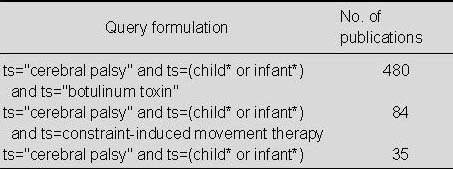
As shown in Table 1, there were 480 articles on the use of botulinum toxin to treat children with cerebral palsy, which is much more than those on the use of CIMT and acupuncture.
Annual publication output relating to the use of botulinum toxin to treat children with cerebral palsy in Web of Science from 2002 to 2011 (Figure 1)
Figure 1.
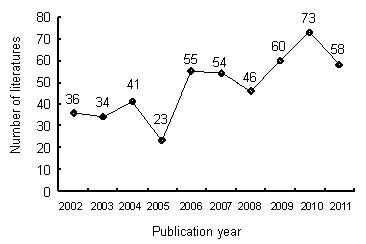
Annual number of publications on botulinum toxin for treating children with cerebral palsy in Web of Science from 2002 to 2011.
A total of 480 publications on botulinum toxin for treating children with cerebral palsy were retrieved from Web of Science from 2002 to 2011. The number of relevant publications increased over the 10-year study period; 36 papers were published and included in Web of Science in 2002, but the number of published papers had increased to 73 in 2010. However, the numbers of papers published heavily decreased in 2005, 2008 and 2011.
Distribution of output by journal for publications on use of botulinum toxin to treat children with cerebral palsy in Web of Science from 2002 to 2011 (Figure 2)
Figure 2.
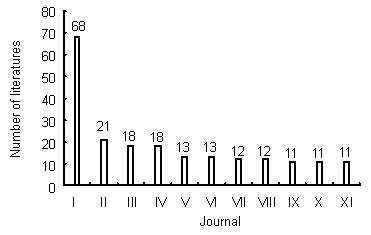
Top 11 journals were selected based on the number of publications on botulinum toxin for treating children with cerebral palsy between 2002 and 2011.
I: Developmental Medicine and Child Neurology; II: Journal of Child Neurology; III: American Journal of Physical Medicine Rehabilitation; IV: Archives of Physical Medicine and Rehabilitation; V: Clinical Rehabilitation VI: Gait Posture; VII: Pediatric Neurology; VIII: Revista de Neurologia; IX: European Journal of Neurology; X: European Journal of Paediatric Neurology; XI: Journal of Rehabilitation Medicine.
Developmental Medicine and Child Neurology published 68 papers, followed by Journal of Child Neurology, American Journal of Physical Medicine Rehabilitation, and Archives of Physical Medicine and Rehabilitation, which published 21, 18 and 18 papers, respectively (Figure 2).
Distribution of output by institution for publications on use of botulinum toxin to treat children with cerebral palsy in Web of Science from 2002 to 2011 (Figure 3)
Figure 3.

The top 11 institutions for publications on botulinum toxin for treating children with cerebral palsy from 2002 to 2011.
I: Murdoch Childrens Research Institute, Australia; II: University of Munich, Germany; III: Radboud University Nijmegen, Netherlands; IV: The University of Melbourne, Australia; V: Yonsei University, Korea; VI: Catholic University of Leuven, USA; VII: Shriners Hosp For Children, USA; VIII: VU University Amsterdam, Netherlands; IX: Sint Maartensklin, Netherlands; X: The University of Auckland, New Zealand; XI: University of Washington, USA.
A total of 480 articles were analyzed by institution. The Murdoch Children's Research Institute in Australia and the University of Munich in Germany were the most prolific research institutes (Figure 3). Four of the top 11 research institutes publishing in this field were in the Netherlands, three were in the United States of America.
Highly cited papers on the use of botulinum toxin to treat children with cerebral palsy in Web of Science from 2002 to 2011 (Table 2)
Table 2.
The top nine cited papers on botulinum toxin for treating children with cerebral palsy from 2002 to 2011
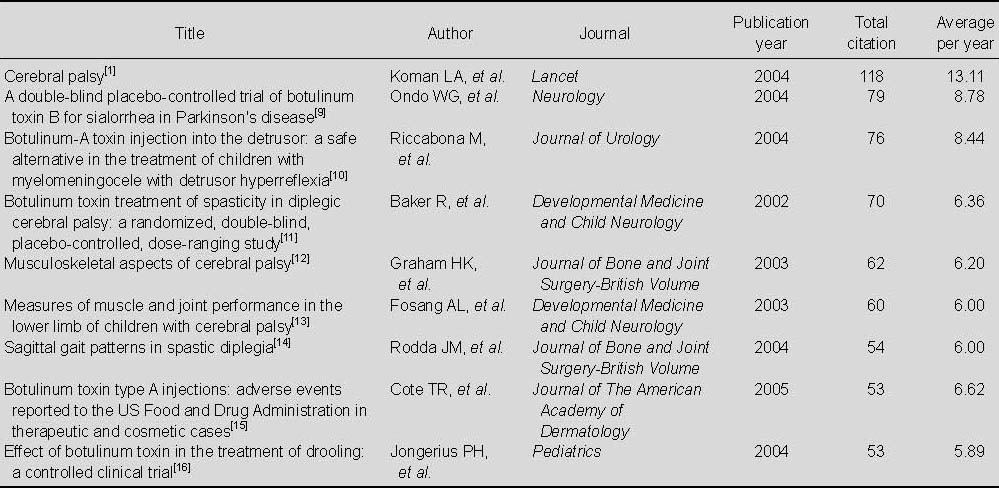
A total of 480 papers on the use of botulinum toxin to treat children with cerebral palsy were cited in Web of Science from 2002 to 2011. “Cerebral palsy”, published in 2004 by the journal Lancet[1], was cited 118 times, which was more times than any other paper. Of the nine most-cited papers, two were published in Developmental Medicine and Child Neurology, two were published in Journal of Bone and Joint Surgery-British Volume; of these nine most-cited papers, five were published in 2004, two in 2003.
Annual publication output relating to CIMT for treating children with cerebral palsy in Web of Science from 2002 to 2011 (Figure 4)
Figure 4.

Annual number of publications on constraint-induced movement therapy for treating children with cerebral palsy in the Web of Science from 2002 to 2011.
A total of 84 publications on the use of CIMT to treat children with cerebral palsy were retrieved from Web of Science from 2002 to 2011. The number of relevant publications increased over the 10-year study period.
Two papers were published and included in Web of Science in 2002, but the number of published papers increased to 20 in 2011. However, numbers of papers published slightly decreased in 2004, 2008 and 2010.
Distribution of output by journal for publications on use of CIMT to treat children with cerebral palsy in Web of Science from 2002 to 2011 (Figure 5)
Figure 5.
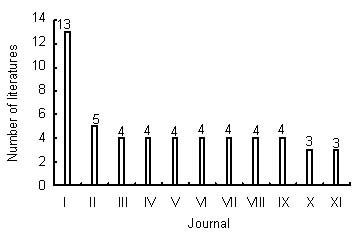
Top 11 journals were selected based on the number of publications on CIMT for treating children with cerebral palsy between 2002 and 2011.
I: Developmental Medicine and Child Neurology; II: Physical Therapy; III: American Journal of Occupational Therapy; IV: American Journal of Physical Medicine Rehabilitation; V: Archives of Physical Medicine and Rehabilitation; VI: Journal of Child Neurology; VII: Neurorehabilitation and Neural Repai; VIII: Pediatrics; IX: Research in Developmental Disabilities; X: Developmental Neurorehabilitation; XI: Disability and Rehabilitation.
As shown in Figure 5, Developmental Medicine and Child Neurology published 13 papers, followed by Physical Therapy, which published five papers.
Distribution of output by institution for publications on use of CIMT to treat children with cerebral palsy in Web of Science from 2002 to 2011 (Figure 6)
Figure 6.
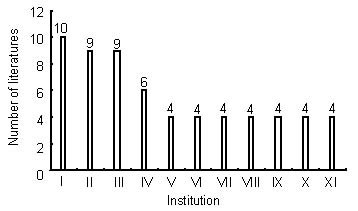
The top 11 institutions for publications on CIMT for treating children with cerebral palsy from 2002 to 2011.
I: Columbia University, USA; II: Emory University, USA; III: University of Queensland, Australia; IV: Howard Florey Institute, Australia’ V: Austin Research Institute, Australia; VI: Karolinska Institute, Swedish; VII: Murdoch Childrens Research Institute, Australia; VIII: The University of Alabama System, USA; IX: University of Children's Hospital, Germany; X: Federal University of Minas Gerais, Brazil; XI: The University of Melbourne, Australia.
A total of 84 articles were analyzed by institution. Columbia University in the United States of America, Emory University in the United States of America, the University of Queensland in Australia and Howard Florey Institute in Australia were the most prolific research institutes (Figure 6). Of the top 11 research institutes publishing in this field, five are in Australia, three are in the United States of America.
Highly cited papers on the use of CIMT to treat children with cerebral palsy in Web of Science from 2002 to 2011 (Table 3)
Table 3.
The top 10 cited papers on constraint-induced movement therapy for treating children with cerebral palsy from 2002 to 2011

A total of 84 papers on the use of CIMT to treat children with cerebral palsy were cited in Web of Science from 2002 to 2011.
“Efficacy of constraint-induced movement therapy for children with cerebral palsy with asymmetric motor impairment”, published in 2004 by the journal Pediatrics [17], was cited 123 times—more times than any other paper on this topic. Of the 10 most-cited papers, five were published in Developmental Medicine and Child Neurology, two in Pediatrics; of these 10 most-cited papers, three were published in 2005, two each in 2006 and 2007.
Annual publication output relating to the use of acupuncture to treat children with cerebral palsy in Web of Science from 2002 to 2011 (Figure 7)
Figure 7.

Annual number of publications on acupuncture for treating children with cerebral palsy in the Web of Science from 2002 to 2011.
A total of 35 publications on the use of acupuncture to treat children with cerebral palsy were retrieved from Web of Science from 2002 to 2011. The number of relevant publications changed irregularly over the 10-year study period; 10 papers were published and included in Web of Science in 2008, seven papers in 2009, and fewer than five papers in each of the other years.
Distribution of output by journal for publications on the use of acupuncture to treat children with cerebral palsy in Web of Science from 2002 to 2011 (Figure 8)
Figure 8.
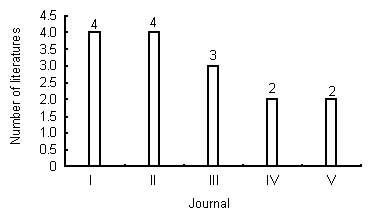
Top five journals were selected based on the number of publications on acupuncture for treating children with cerebral palsy between 2002 and 2011.
I: Developmental Medicine and Child Neurology;
II: Journal of Child Neurology;
III: Journal of Alternative and Complementary Medicine;
IV: European Journal of Paediatric Neurology;
V: Neural Regeneration Research.
Developmental Medicine and Child Neurology and Journal of Child Neurology each published four papers, three papers were in Journal of Alternative and Complementary Medicine, and two papers each were in European Journal of Paediatric Neurology, Neural Regeneration Research (Figure 8).
Distribution of output by institution for publications on the use of acupuncture to treat children with cerebral palsy in Web of Science from 2002 to 2011
A total of 35 articles were analyzed by institution. The University of Hong Kong in China and Capital Medical University in China were the most prolific research institutes (Figure 9). They published five and three papers, respectively. And there was another prolific research institute in China that is Chinese People's Liberation Army General Hospital. Of the other five top research institutes publishing in this field, two were in Sweden, another two were in the United States of America, and one institute was in Canada.
Figure 9.
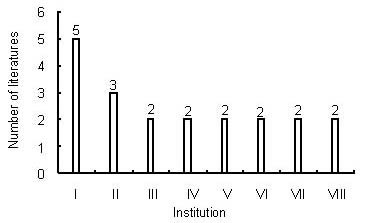
The top eight institutions for publications on acupuncture for treating children with cerebral palsy from 2002 to 2011.
I: University of Hong Kong, China; II: Capital Medical University, China; III: Chinese People's Liberation Army General Hospital, China; IV: Örnsköldsviks Hospital, Sweden; V: University of Alberta, Canada; VI: University of Arizona, USA; VII: University of California System, USA VIII: University of Gothenburg, Sweden.
Highly cited papers on the use of acupuncture to treat children with cerebral palsy in Web of Science from 2002 to 2011 (Table 4)
Table 4.
The top 10 cited papers on acupuncture for treating children with cerebral palsy from 2002 to 2011
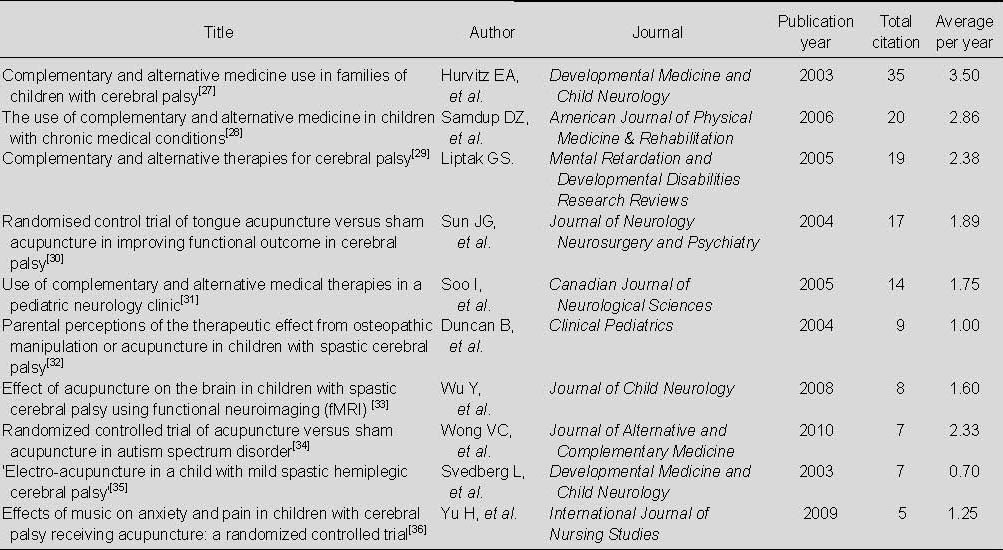
A total of 35 papers on the use of acupuncture to treat children with cerebral palsy were cited in Web of Science from 2002 to 2011. “Complementary and alternative medicine use in families of children with cerebral palsy”, published in 2003 by Developmental Medicine and Child Neurology[27], was cited 35 times—more times than any other paper on this topic. Of the 10 most-cited papers, two were published in Developmental Medicine and Child Neurology.
DISCUSSION
Bibliometric analysis, based on Web of Science publications, identified several research trends over the past 10 years in studies of botulinum toxin, CIMT and acupuncture as treatments for children with cerebral palsy. Many more articles have been published on the use of botulinum toxin to treat these children than on the use of CIMT or acupuncture. Although the number of publications increased over the 10-year study period, the increase was irregular. Most papers appeared in journals with a focus on neurology, such as Developmental Medicine and Child Neurology, Journal of Child Neurology. Research institutes publishing on the use of botulinum toxin to treat children with cerebral palsy are mostly in the Netherlands, the United States of America, and Australia; those publishing on the use of CIMT to treat these children are mostly in Australia and the United States of America; and those publishing on the use of acupuncture to treat them are mostly in China, Sweden and the United States of America. So far, there is no one specific therapy that can cure cerebral palsy effectively alone. There are more than 10 types of treatments for cerebral palsy. Doctors are inclined to use comprehensive applications of two or three treatments[37,38]. Botulinum toxin is commonly used to reduce spasticity and dystonia in children with cerebral palsy. CIMT is emerging as a treatment approach for children with hemiplegic cerebral palsy. Acupuncture, developed as a school of its own, has made progress in terms of basic research and clinical applications. Because of the complex pathogenesis of cerebral palsy and the wide variation in associated brain damage, clinical treatment of cerebral palsy is difficult [39,40]. Single treatments rarely achieve the desired therapeutic effect; comprehensive approaches are necessary, possibly with a regimen of various integrated treatments[41,42,43]. We should pay attention to the relevance and effectiveness of treatment methods and options.
Footnotes
Conflicts of interest: None declared.
(Edited by Mu WJ/Song LP)
REFERENCES
- [1].Koman LA, Smith BP, Shilt JS. Cerebral palsy. Lancet. 2004;363(9421):1619–1631. doi: 10.1016/S0140-6736(04)16207-7. [DOI] [PubMed] [Google Scholar]
- [2].Aisen ML, Kerkovich D, Mast J, et al. Cerebral palsy: clinical care and neurological rehabilitation. Lancet Neurol. 2011;10(9):844–852. doi: 10.1016/S1474-4422(11)70176-4. [DOI] [PubMed] [Google Scholar]
- [3].Bax M, Goldstein M, Rosenbaum P, et al. Proposed definition and classification of cerebral palsy, April 2005. Dev Med Child Neurol. 2005;47(8):571–576. doi: 10.1017/s001216220500112x. [DOI] [PubMed] [Google Scholar]
- [4].Duley L. The global impact of pre-eclampsia and eclampsia. Semin Perinatol. 2009;33(3):130–137. doi: 10.1053/j.semperi.2009.02.010. [DOI] [PubMed] [Google Scholar]
- [5].Tilton AH. Approach to the rehabilitation of spasticity and neuromuscular disorders in children. Neurol Clin. 2003;21(4):853–881. doi: 10.1016/s0733-8619(03)00066-5. [DOI] [PubMed] [Google Scholar]
- [6].Haynes RL, Baud O, Li J, et al. Oxidative and nitrative injury in periventricular leukomalacia: a review. Brain Pathol. 2005;15(3):225–233. doi: 10.1111/j.1750-3639.2005.tb00525.x. [DOI] [PMC free article] [PubMed] [Google Scholar]
- [7].Wiart L, Darrah J, Kembhavi G. Stretching with children with cerebral palsy: what do we know and where are we going? Pediatr Phys Ther. 2008;20(2):173–178. doi: 10.1097/PEP.0b013e3181728a8c. [DOI] [PubMed] [Google Scholar]
- [8].Pin T, Dyke P, Chan M. The effectiveness of passive stretching in children with cerebral palsy. Dev Med Child Neurol. 2006;48(10):855–862. doi: 10.1017/S0012162206001836. [DOI] [PubMed] [Google Scholar]
- [9].Ondo WG, Hunter C, Moore W. A double-blind placebo-controlled trial of botulinum toxin B for sialorrhea in Parkinson's disease. Neurology. 2004;62(1):37–40. doi: 10.1212/01.wnl.0000101713.81253.4c. [DOI] [PubMed] [Google Scholar]
- [10].Riccabona M, Koen M, Schindler M, et al. Botulinum-A toxin injection into the detrusor: a safe alternative in the treatment of children with myelomeningocele with detrusor hyperreflexia. J Urol. 2004;171(2 Pt 1):845–848. doi: 10.1097/01.ju.0000108892.35041.2d. [DOI] [PubMed] [Google Scholar]
- [11].Baker R, Jasinski M, Maciag-Tymecka I, et al. Botulinum toxin treatment of spasticity in diplegic cerebral palsy: a randomized, double-blind, placebo-controlled, dose- ranging study. Dev Med Child Neurol. 2002;44(10):666–675. doi: 10.1017/s0012162201002730. [DOI] [PubMed] [Google Scholar]
- [12].Kerr Graham H, Selber P. Musculoskeletal aspects of cerebral palsy. J Bone Joint Surg Br. 2003;85(2):157–166. doi: 10.1302/0301-620x.85b2.14066. [DOI] [PubMed] [Google Scholar]
- [13].Fosang AL, Galea MP, McCoy AT, et al. Measures of muscle and joint performance in the lower limb of children with cerebral palsy. Dev Med Child Neurol. 2003;45(10):664–670. doi: 10.1017/s0012162203001245. [DOI] [PubMed] [Google Scholar]
- [14].Rodda JM, Graham HK, Carson L, et al. Sagittal gait patterns in spastic diplegia. J Bone Joint Surg Br. 2004;86(2):251–258. doi: 10.1302/0301-620x.86b2.13878. [DOI] [PubMed] [Google Scholar]
- [15].Cote TR, Mohan AK, Polder JA, et al. Botulinum toxin type A injections: adverse events reported to the US Food and Drug Administration in therapeutic and cosmetic cases. J Am Acad Dermatol. 2005;53(3):407–415. doi: 10.1016/j.jaad.2005.06.011. [DOI] [PubMed] [Google Scholar]
- [16].Jongerius PH, van den Hoogen FJA, van Limbeek J, et al. Effect of botulinum toxin in the treatment of drooling: a controlled clinical trial. Pediatrics. 2004;114(3):620–627. doi: 10.1542/peds.2003-1104-L. [DOI] [PubMed] [Google Scholar]
- [17].Taub E, Ramey SL, DeLuca S, et al. Efficacy of constraint-induced movement therapy for children with cerebral palsy with asymmetric motor impairment. Pediatrics. 2004;113(2):305–312. doi: 10.1542/peds.113.2.305. [DOI] [PubMed] [Google Scholar]
- [18].Eliasson AC, Krumlinde-Sundholm L, Shaw K, et al. Effects of constraint-induced movement therapy in young children with hemiplegic cerebral palsy: an adapted model. Dev Med Child Neurol. 2005;47(4):266–275. doi: 10.1017/s0012162205000502. [DOI] [PubMed] [Google Scholar]
- [19].Charles JR, Wolf SL, Schneider JA, et al. Efficacy of a child-friendly form of constraint-induced movement therapy in hemiplegic cerebral palsy: a randomized control trial. Dev Med Child Neurol. 2006;48(8):635–642. doi: 10.1017/S0012162206001356. [DOI] [PubMed] [Google Scholar]
- [20].Johnston MV. Plasticity in the developing brain: implications for rehabilitation. Dev Disabil Res Rev. 2009;15(2):94–101. doi: 10.1002/ddrr.64. [DOI] [PubMed] [Google Scholar]
- [21].Willis JK, Morello A, Davie A, et al. Forced use treatment of childhood hemiparesis. Pediatrics. 2002;110(1 Pt 1):94–96. doi: 10.1542/peds.110.1.94. [DOI] [PubMed] [Google Scholar]
- [22].Gordon AM, Charles J, Wolf SL. Methods of constraint-induced movement therapy for children with hemiplegic cerebral palsy: development of a child-friendly intervention for improving upper-extremity function. Arch Phys Med Rehabil. 2005;86(4):837–844. doi: 10.1016/j.apmr.2004.10.008. [DOI] [PubMed] [Google Scholar]
- [23].Gordon AM, Schneider JA, Chinnan A, et al. Efficacy of a hand-arm bimanual intensive therapy (HABIT) in children with hemiplegic cerebral palsy: a randomized control trial. Dev Med Child Neurol. 2007;49(11):830–838. doi: 10.1111/j.1469-8749.2007.00830.x. [DOI] [PubMed] [Google Scholar]
- [24].Hoare B, Imms C, Carey L, et al. Constraint-induced movement therapy in the treatment of the upper limb in children with hemiplegic cerebral palsy: a Cochrane systematic review. Clin Rehabil. 2007;21(8):675–685. doi: 10.1177/0269215507080783. [DOI] [PubMed] [Google Scholar]
- [25].Naylor CE, Bower E. Modified constraint-induced movement therapy for young children with hemiplegic cerebral palsy: a pilot study. Dev Med Child Neurol. 2005;47(6):365–369. doi: 10.1017/s0012162205000721. [DOI] [PubMed] [Google Scholar]
- [26].Charles J, Gordon AM. Development of hand-arm bimanual intensive training (HABIT) for improving bimanual coordination in children with hemiplegic cerebral palsy. Dev Med Child Neurol. 2006;48(11):931–936. doi: 10.1017/S0012162206002039. [DOI] [PubMed] [Google Scholar]
- [27].Hurvitz EA, Leonard C, Ayyangar R, et al. Complementary and alternative medicine use in families of children with cerebral palsy. Dev Med Child Neurol. 2003;45(6):364–370. doi: 10.1017/s0012162203000707. [DOI] [PubMed] [Google Scholar]
- [28].Samdup DZ, Smith RG, Song S., II The use of complementary and alternative medicine in children with chronic medical conditions. Am J Phys Med Rehabil. 2006;85(10):842–846. doi: 10.1097/01.phm.0000233183.17059.b9. [DOI] [PubMed] [Google Scholar]
- [29].Liptak GS. Complementary and alternative therapies for cerebral palsy. Ment Retard Dev Disabil Res Rev. 2005;11(2):156–163. doi: 10.1002/mrdd.20066. [DOI] [PubMed] [Google Scholar]
- [30].Sun JG, Ko CH, Wong V, et al. Randomised control trial of tongue acupuncture versus sham acupuncture in improving functional outcome in cerebral palsy. J Neurol Neurosurg Psychiatry. 2004;75(7):1054–1057. doi: 10.1136/jnnp.2003.021485. [DOI] [PMC free article] [PubMed] [Google Scholar]
- [31].Soo I, Mah JK, Barlow K, et al. Use of complementary and alternative medical therapies in a pediatric neurology clinic. Can J Neurol Sci. 2005;32(4):524–528. doi: 10.1017/s0317167100004558. [DOI] [PubMed] [Google Scholar]
- [32].Duncan B, Barton L, Edmonds D, et al. Parental perceptions of the therapeutic effect from osteopathic manipulation or acupuncture in children with spastic cerebral palsy. Clin Pediatr (Phila) 2004;43(4):349–353. doi: 10.1177/000992280404300406. [DOI] [PubMed] [Google Scholar]
- [33].Wu Y, Jin Z, Li K, et al. Effect of acupuncture on the brain in children with spastic cerebral palsy using functional neuroimaging (FMRI) J Child Neurol. 2008;23(11):1267–1274. doi: 10.1177/0883073808318049. [DOI] [PubMed] [Google Scholar]
- [34].Wong VC, Sun JG. Randomized controlled trial of acupuncture versus sham acupuncture in autism spectrum disorder. J Altern Complement Med. 2010;16(5):545–553. doi: 10.1089/acm.2007.0768. [DOI] [PubMed] [Google Scholar]
- [35].Svedberg L, Nordahl G, Lundeberg T. Electro-acupuncture in a child with mild spastic hemiplegic cerebral palsy. Dev Med Child Neurol. 2003;45(7):503–504. doi: 10.1017/s0012162203000938. [DOI] [PubMed] [Google Scholar]
- [36].Yu H, Liu Y, Li S, et al. Effects of music on anxiety and pain in children with cerebral palsy receiving acupuncture: a randomized controlled trial. Int J Nurs Stud. 2009;46(11):1423–1430. doi: 10.1016/j.ijnurstu.2009.05.007. [DOI] [PubMed] [Google Scholar]
- [37].Garry MI, Kamen G, Nordstrom MA. Hemispheric differences in the relationship between corticomotor excitability changes following a fine-motor task and motor learning. J Neurophysiol. 2004;91(4):1570–1578. doi: 10.1152/jn.00595.2003. [DOI] [PubMed] [Google Scholar]
- [38].Blauw-Hospers CH, Hadders-Algra M. A systematic review of the effects of early intervention on motor development. Dev Med Child Neurol. 2005;47(6):421–432. doi: 10.1017/s0012162205000824. [DOI] [PubMed] [Google Scholar]
- [39].Johnston MV. Plasticity in the developing brain: implications for rehabilitation. Dev Disabil Res Rev. 2009;15(2):94–101. doi: 10.1002/ddrr.64. [DOI] [PubMed] [Google Scholar]
- [40].Binks JA, Barden WS, Burke TA, et al. What do we really know about the transition to adult-centered health care A focus on cerebral palsy and spina bifida. Arch Phys Med Rehabil. 2007;88(8):1064–1073. doi: 10.1016/j.apmr.2007.04.018. [DOI] [PubMed] [Google Scholar]
- [41].Sakzewski L, Boyd R, Ziviani J. Clinimetric properties of participation measures for 5- to 13-year-old children with cerebral palsy: a systematic review. Dev Med Child Neurol. 2007;49(3):232–240. doi: 10.1111/j.1469-8749.2007.00232.x. [DOI] [PubMed] [Google Scholar]
- [42].Calvert JW, Zhang JH. Pathophysiology of an hypoxicischemic insult during the perinatal period. Neurol Res. 2005;27(3):246–260. doi: 10.1179/016164105X25216. [DOI] [PubMed] [Google Scholar]
- [43].Bachrach LK, Ward LM. Clinical review 1: Bisphosphonate use in childhood osteoporosis. J Clin Endocrinol Metab. 2009;94(2):400–409. doi: 10.1210/jc.2008-1531. [DOI] [PubMed] [Google Scholar]


